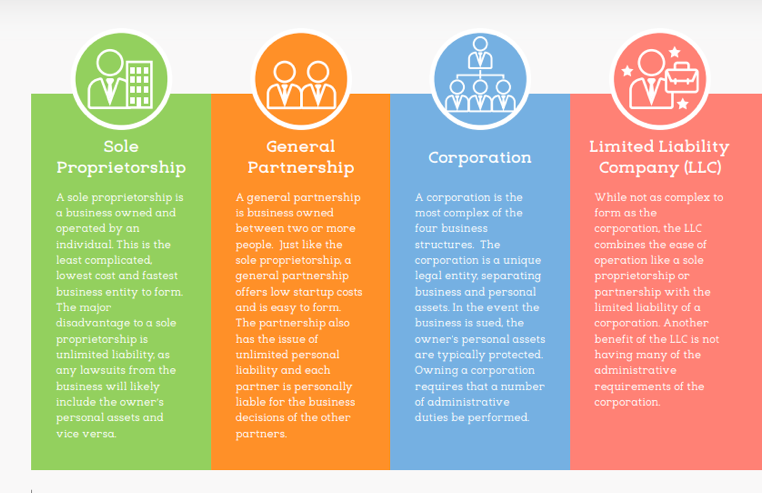Starting a business comes with multiple steps and processes that can overwhelm you. To make your life simpler, reference our checklist for starting a business below. It can help you if you don’t have the know-how to create your own startup checklist. Either way, having a physical list of items you can check off will make starting a business much smoother.
1. Gather your ideas
If you’ve had business ideas running around inside your head for a while, the first item on your checklist is to narrow those ideas down to those that could be an actual business. Flesh contrasting ideas out, and separate them to get an idea for what will work and what won’t.
It’s best to start with the type of business, and ask yourself these questions:
• Do you want a service-based or product-based business?
• What services or products will you offer?
• How will you offer them?
• Where will you source your products?
• What is your business called?
2. Determine your audience
Who is buying your products and using your services? That’s the next line item in your new business checklist. Without customers, your business will fail. This list item and the next one can actually be done interchangeably, and here’s why.
You can figure out who your audience is by first deciding the customers you want to attract and then conducting market research to discover where those people are. Once you find where they are, it will be easier to gear your business toward them.
On the flip side, you can conduct market research first to see where businesses like yours do well, and use that information to pinpoint your audience. Let’s go deeper into market research.
3. Research the market
Third on our list is market research. When you’re researching markets for your business, you are doing so for many reasons. One is to narrow down your target audience. Whether you research the market first, and then determine your audience, or determine your audience first, and then use that information to conduct market research, this step is crucial.
Here’s what you’re trying to find with market research:
• How many other businesses like yours exist in a given area
• Who their customers are
• How the businesses are doing
• What other types of business exist in the area
• What might prevent your business from succeeding
It’s a balance between wanting to be where businesses like yours succeed and being where your business won’t immediately be bogged down by competition. If you want to start an online business, this checklist item remains much the same, but now you’re dealing with the whole internet, as opposed to a city or town.
4. Test your ideas
There’s no harm in running your business ideas by family and friends. Hopefully, they’re the people who will give you the most honest feedback because they should be the people who want you to succeed the most.
Present them with a business name idea, sample products or service ideas, marketing ideas, and anything else you can think of that would benefit from outside input. Maybe choose two versions of everything, present them to separate groups, and see which ones get the best responses. This should help guide you in the right direction.
5. Write a business plan
Whether this is the first or fifth business you’re starting, writing a small business plan should always be on your business startup checklist. The type of business plan, and how much detail you go into, depends on a few things. If you need funding from investors or loans from banks to get up and running, you’ll want to write a much more detailed business plan with extensive financial projections. This is the only way investors or banks will know how you plan to pay back the money. The more specific you can be, the better.
If you’re writing the business plan to organize your thoughts or present it to a focus group for feedback, you can take a much more relaxed approach, and even use one of the many one-page business plans available online. Regardless of which you choose, these are the most common sections you’ll find in any business plan:
• Executive summary
• Company description
• Products and services explanation
• Market analysis
• Marketing plan
• Management organization
• Financial plan and projections
6. Secure funding
If you need funding, secure it before moving on. You might be wondering how you’ll know how much money to ask for when you haven’t found a space, haven’t bought equipment, purchased inventory, etc. Those are all valid concerns, but they should be worked out when preparing your business plan.
You’ll have to research necessary equipment and materials, real estate costs, marketing, upkeep, etc. to write your business plan and create a realistic business budget. By the end, you should have a good idea of the funds you’ll need.
Here’s where it gets tricky. Online lenders don’t necessarily care about your business plan. Here’s what they look at instead to determine if, and for how much, you qualify:
• Current financials (personal and/or business)
• Credit score and history
• Time in business
• Assets that can be used as collateral
If you go with an online lender, pay close attention to interest rates, payback time frames, and other fine print.
7. Choose a business structure and register your business
Initially, you’ll likely be a sole proprietor, and it’s highly recommended you choose a business structure and register your business for tax and legal purposes. Here are the ones you’ll most likely choose from:
• Sole proprietorship
• Limited liability company (LLC)
• Corporation
• General partnership

You’ll have to register in each state you plan to do business, and it can be tricky to understand, especially for a newcomer. If you don’t have an attorney on hand to help you with this, online legal services such as MyCorporation, LegalZoom, or Rocket Lawyer, can help with business formation, registering, legal documents, business tax preparation, and much more.
8. Acquire any permits or licenses
Aside from permits you’ll need to do business in a physical location, such as a certificate of occupancy from the city, you’ll need general business licenses and permits to legally conduct business. Here’s a sampling of some of those licenses:
• General business license
• Sales tax permit
• Zoning permit
• Home occupation permit (if you’re running your business out of your home)
There might be other licenses and permits since they vary from state to state, so make sure to check with your state to see about other requirements before you open for business.
9. Think about branding
No matter what type of business you operate, you’ll need a brand concept. This will make your business recognizable. Once a customer has seen your business website, for example, the logo, colors, fonts, and patterns should be the same across the board. Carry that branding over to the following:
• Business cards
• Flyers and pamphlets
• Packaging
• Signage
• Advertisements
• Social media
Anywhere your business is represented, implement your standard branding elements to keep everything consistent.

10. Advertise your business
Now that you have all the legal and formal stuff out of the way, you can get into the more fun aspects of starting a business. It’s time to get your business out to the masses, and the best way to do that is to advertise. It’s up to you how you do it, and there are plenty of options. Here are the most popular, no matter the business:
• Social media
• Local television commercials
• Newspaper or local magazine
• Radio advertising
• Networking events with your local Chamber of Commerce
Some advertising can be free, such as basic social media, but most will come with a cost that you’ll have to work into your overall business marketing plan and advertising budget.
The bottom line
The above is a list of things needed to start a business, but it’s by no means comprehensive. There are countless other things you need to start a business, but the items listed above are ones you absolutely can’t start a business without. Go through the list and check things off as you complete them, and you’ll be well on your way to business success.
The post 10 Checklist Items to Help Start Your Small Business appeared first on The blueprint and is written by Jennifer Post
Original source: The blueprint






